In this article, you’ll learn are different types of chain drives, their working, advantages, disadvantages, and applications.
You can download a PDF file of this post at the end of it.
What is a Chain Drive?
Chain drives are suitable for small center distances and can be used generally up to 3 meters but in special cases even up to 8 meters. Chain drives transmit power up to 100kw and operating peripheral velocity up to 15m/s. The velocity ratio can be as high as 8:1.
The main disadvantage of the belt drives and the rope drives is that the velocity ratio does not remain constant, but varies on account of slip. Since chain drives are positive drives there is no slip, hence the velocity ratio will remain constant.
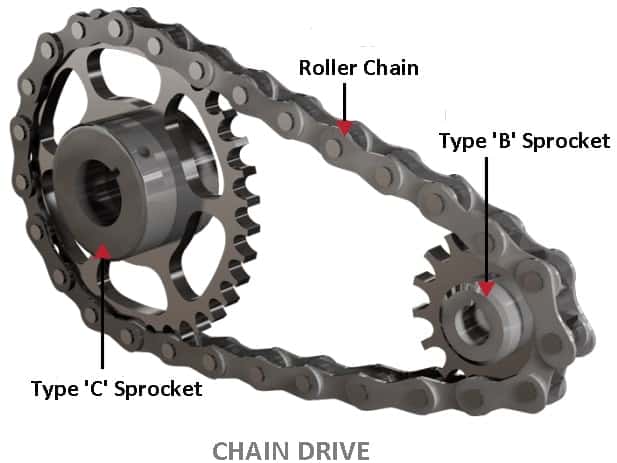
Chain drives are employed for a wide range of power transmission applications, like in bicycles, motorcycles, rolling mills, agricultural machinery, machine tools, conveyors, coal cutters, etc. A chain drive consists of a chain and two wheels, called Sprockets. The sprockets are toothed wheels over which an endless chain is fitted.
Types of Chain Drives
Chain drive designs have evolved as a result of their employment in a wide range of mechanical applications. They can be divided into many groups based on the criteria we use to evaluate them.
Chain drives can be classified into three categories based on their function.
#1 Power Transmission Chain Drives
The purpose of this type of chain drive is to transfer power between two shafts. The majority of devices that generate power—such as pumps with associated motors—are unable to use it simultaneously.
Transmission systems use a variety of technologies to deliver power to consumers. For this purpose, chains are used which are known as power transmission chains.
Chain drives are generally used in bicycles, farm equipment, compressors, engine camshafts, etc. are typical examples.
#2 Conveyor Chain Drive
Chain drives are utilized by conveyors; these drives are specifically designed to move materials. They have characteristics like strong temperature and chemical resistance, reduced friction, and hundreds of various designs.
Conveyor chain drives are used in the food and beverage processing, automotive, textile, packaging, and pharmaceutical industries.
#3 Hoisting and Hauling Chain Drive
The most popular piece of equipment for raising and lowering machines is a chain hoist. Pulleys allow them to raise large amounts of weight with little effort.
Hand chain hoists, also known as chain blocks, are frequently found in many factories, workshops, ship engine rooms, and garages. They can hoist and lower big weights weighing up to 20 tonnes and they may be pneumatic, electronic, or manual.
There are two basic categories of hoist chains:
1. Oval Link Chains (Coil Chains): Oval link chains, also known as coil chains, are ideal for low- to medium-load hoisting applications, particularly those requiring low-speed lifting.
2. Stud Link Chains: Stud link chains, on the other hand, are ideal for high-load lifting applications. These chains have studs across their inner diameter, which effectively prevents kinking while increasing overall strength and durability.
Types of Chains Used in Power Transmission
- Roller chain
- Silent chain
- Leaf Chain
- Flat-top Chain
- Engineering Steel Chain
Regardless of the types of chains, their styles are classified as follows.
- Straight link chains, which have alternate ‘outside’ and ‘inside’ links.
- Offset link chains, which have all links alike. These include integral link chains, such as bar-link, flat-top, and welded steel chains,
Roller chains are commonly used in bicycles, motorcycles, machine tools, etc. A silent chain is an inverted tooth chain that is extensively used for smooth and noiseless operations at low velocities.
Types of Chains
From an industry standpoint, the major types of chains are as follows:
1. Roller Chain (Bush Roller Chain)
This type of chains is most commonly used for the transmission of mechanical power on many kinds of domestic, industrial, and agricultural machinery, including conveyors, wire- and tube-drawing machines, printing presses, cars, motorcycles, and bicycles.
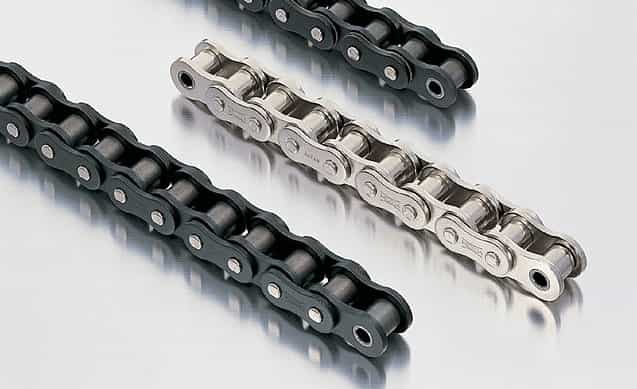
Roller chain consists of a series of short cylindrical rollers held together by side links. It is driven by a toothed wheel called a sprocket. It is simple, reliable, and efficient for power transmission.
These chains are generally smaller in diameter than the height of the link plates of the chain. the link plates serve as guides when the chain engages the sprockets,
Chains also served as a guide to support material carried on it on tracks or ways, as is characteristic of conveyors and some bucket elevators. Roller chains are used for both drive and conveyor applications.
- The most commonly used chain for drives is the single-strand standard series roller chain. The power rating capacities of these chains cover a wide range of drive load requirements.
- Multiple-strand roller chains are used to provide increased power capacity without the need for increasing the chain pitch or its linear speed.
2. Silent Chain
The silent chain also called inverted tooth chain, consists of a series of toothed link plates assembled on joint components in a way that allows free flexing between each pitch.
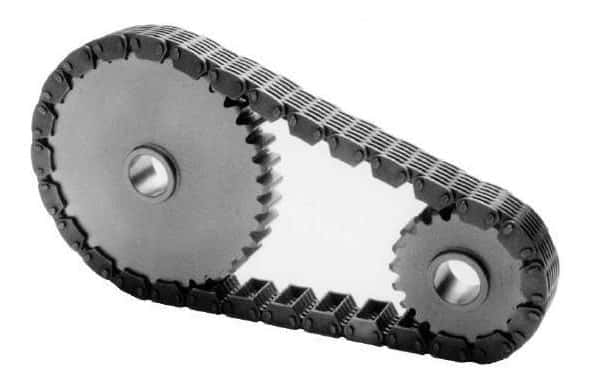
Silent chains are made up of stacked rows of flat link plates with gear-type contours designed to engage sprocket teeth like the way a rack engages a gear as shown in the figure. The links are held together at each chain joint by one or more pins, which also allow the chain to flex.
Silent chains from different manufacturers usually cannot be connected. Standard silent chains are used in a wide variety of industrial drives where a compact, high-speed, smooth, low-noise drive is required.
High-performance silent chains are available in a wide range of sizes with pitches and in widths and are used on very-high-speed drives where exceptional smoothness and quietness are required. These chains are commonly used in industrial equipment where ultimate smoothness is required.
3. Leaf Chain
Leaf chains are designed for lifting rather than power transmission. Tensions are very high, but speeds are slow. Normally the chains work intermittently. The main considerations in the design of the leaf chains are tensile loads, joint wear, and link plate and sheave wear.
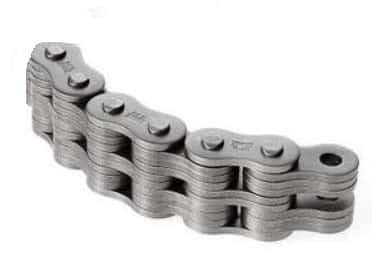
Leaf chains don’t mesh with sprockets, because they are intended to run over sheaves, so there is no provision for them to engage a sprocket. Leaf chains must often lift very large loads, and hence they need high yield strength and do not get permanently stretched when they lift large loads. The most common use for leaf chains is probably on lift trucks.
4. Flat-top Chain
Flat-top chains are widely used on conveyors, most basically used on the special type of slat conveyor.
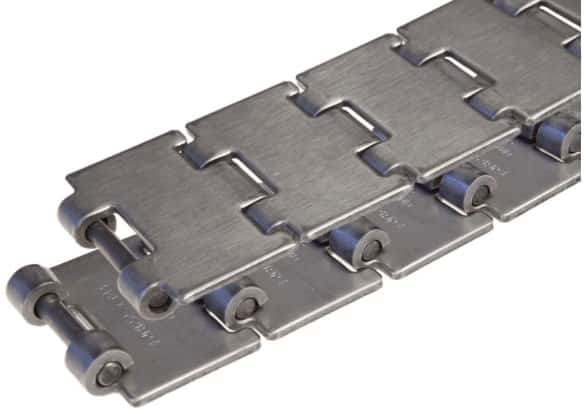
The Flat-top chain consists of.
- A series of steel top plates with hinge-like barrels curled on each side.
- Pins are inserted through the barrels to make a joint. These act as both beams and bearings.
- Pins are retained by press fits or heading in the barrels of one top plate and are free to articulate in the barrels of the next link.
- The connecting pin is usually either knurled or enlarged on one end to retain the pin in one barrel of the top plate.
- Thus a continuous length of the flat-top chain is formed.
- The flat-top chain is intended only for conveying.
5. Engineering Steel Chain
Engineering steel chains were first developed in the 1880s and were designed for difficult conveying applications. Most engineering steel chains are used in conveyors, bucket elevators, and tension linkages.
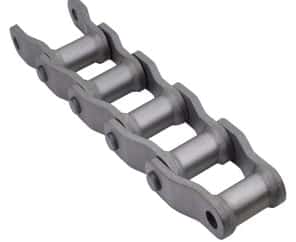
Only a few are used in drives. The main design considerations for these chains are tensile loads, several types of wear, lubrication, and the
Wear the most important parameters while designing an engineering steel chain. Joint wear, roller and bushing wear, and sidebar and track wear all are of great concern for conveyor chains.
The Chain Used In Bicycle
Most bicycle chains are made from plain carbon or alloy steel, but some are nickel-plated to prevent rust or simply for stylish.

Chain drive was the main feature that modified the safety bicycle introduced in 1885, with its two equal-sized wheels, from the “high wheeler” type of bicycle. The popularity of chain-driven safety is still a basic feature of bicycle design today.
A bicycle chain has a very high efficiency because it moves the point of pressure farther away from the axle, putting less stress on the bearings, and thus reducing friction in the inner wheel. The higher chain tension was found to be more efficient.
Chain Drives In Automobile Vehicles
A chain-drive system transmits power from a differential to the rear axle in a vehicle.

Back in the earlier days of the automobile chain drives were the very popular power transmission system. It gained prominence as an alternative to the Système Panhard with its rigid Hotchkiss, Driveshaft, and universal joints.
Chain drives are simpler to design than driveshaft and universal joints.
Because of less unsprung weight at the rear wheels, it allows the suspension to react to bumps more effectively. By this means the vehicle would have a smoother ride.
Advantages and Disadvantages of Chain Drives
Advantages
- They are positive non-sail drives.
- Efficiency is very high (up to 99%).
- It can be employed for the shaft which is small as well as large center distances up to 3m.
- They permit a high-velocity ratio of up to 8:1 in one step.
- They can transmit higher power than belt drives.
- Because the sprockets are lighter than the pulleys, they produce less stress on the shafts compared to the belt drives.
- Unlike belt drives, they can operate under adverse temperatures and atmospheric conditions.
- They occupy less space and are more compact than belt drives.
- Maintenance is low.
Disadvantages
- The driving and driven shaft should be accurately aligned so that their axes are exactly parallel.
- Requires more lubrication.
- High initial cost.
- Stretching of the chin makes it impossible for the operation to have periodic reversals.
- Velocity fluctuations are more.
Difference Between Belt Drive and Chain Drive
A comparison between belt drive and chain drive is shown in the table below.
| Features | Belt Drive | Chain Drive |
|---|---|---|
| Transmission | A belt drive is continuous and flexible. | Chain drives are discontinuous and rigid. |
| Construction | The belt is composed of rubber or synthetic materials. | The chain is constructed of metal. |
| Efficiency | It is generally more efficient due to decreased friction. | It generally has poor efficiency because of higher friction. |
| Maintenance | It requires minimal manitenance. | It requires regular maintenance and tension adjustment. |
| Noise Level | These are quieter to operate. | They can be louder, particularly at high speeds. |
| Speed Range | Belt drives have limited use in high-speed applications. | Chain drives can handle a wide range of speeds. |
| Load Capacity | Belt drives offer a lower load-carrying capacity. | Chain drives are more capable of handling heavy loads. |
| Cost | Belt drives are typically less expensive to produce. | Chain drives might be more expensive to produce. |
| Durability | It generally results in a longer belt life. | Chains may need to be replaced since they have a shorter lifespan. |
| Slip | Heavy weights may cause belt drives to slip. | Chain drives are less likely to slip under strong loads. |
Wrapping It Up
That’s it thanks for reading. We have discussed all the types of chains I know this article isn’t finished yet but still, if you have any questions about this topic you can ask in the comments. If you like this article then please share it with your friends.
Subscribe to our newsletter to get the latest information about engineering topics.
You can download this PDF file by clicking the below link:
Read also
- Rope Drive: Transmission Of Power By Rope Drive
- Transmission of Power: Belt Drives and Types of Belt Drives
- What is a Conveyor System? Its Parts, Types, and Applications
FAQs
A chain drive is a mechanical power transmission system that uses chains to move power from one location to another.
The roller chain or bush roller chain is one of the most common types of chain drive used on domestic, industrial, and agricultural machinery, including conveyors, wire- and tube-drawing machines, printing presses, cars, motorcycles, and bicycles.
The chain drive can transfer torque over great distances. Compared to a belt drive, a chain drive is smaller and more space-efficient. A single chain drive can power several shafts.
They are incompatible with shafts that are not parallel. Chain drives are noisy and vibration-prone. Certain chain drive designs need to be lubricated continuously.
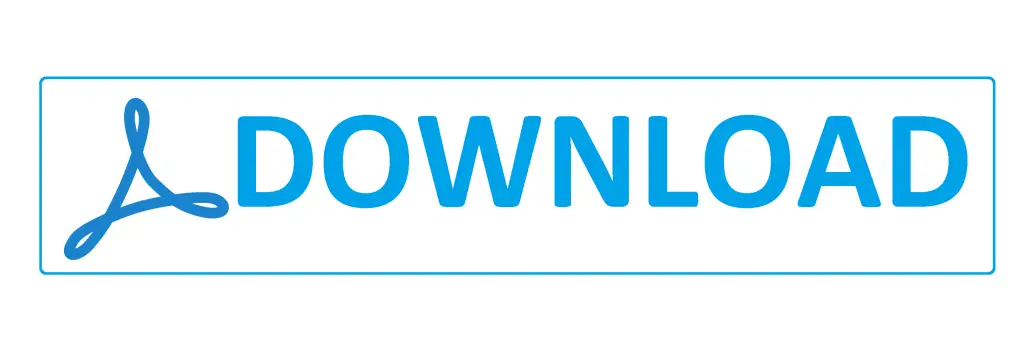
I am currently writing a paper and a bug appeared in the paper. I found what I wanted from your article. Thank you very much. Your article gave me a lot of inspiration. But hope you can explain your point in more detail because I have some questions, thank you.
Thank you for your kind words and feedback. I’d be happy to provide more detailed explanations for any questions you have.
It is very important and helpful. thank you very much .
You’re welcome 🙂
That’s good to know that the efficacy of a chain driver would be really high. I would think that would be a good way to save energy on a machine. I’ll have to consider using some of those and try the different chains if I decide to build a go-cart for my kids.